Looking Closer at BPF Bytecode in BPFDoor
Metadata
- SHA256: afa8a32ec29a31f152ba20a30eb483520fe50f2dce6c9aa9135d88f7c9c511d7
- Malware Bazaar link
Table of Contents
Family Introduction
BPFDoor is a backdoor targeting Linux-based systems. It leverages Berkeley Packet Filter (BPF) technology that exists natively in Linux kernels since v2.1.75. By using low-level BPF-based packet filtering, it is able to bypass local firewalls and stealthily receive network traffic from its C2.
BPF Introduction
The Need for BPF
An operating system (OS) abstracts away the hardware. For example, user-space programs running on the OS do not directly interact with networking-related hardware. They do so via APIs exposed by the OS. On Linux, these are called system calls or syscalls, in short. This kind of a design results in a clear demarcation between the user-space and kernel-space.
Consider a single network packet that reaches the kernel. A user-space packet filtering program wants to look at it. In this case, the contents of the entire packet needs to be copied into user-space memory for it to be accessible by the user-space program. This incurs a cost in performance and can be expected to be significant on high-traffic systems.
With the introduction of BPF in Linux kernel v2.1.75, packet filtering can occur in kernel-space. A user-space application such as tcpdump could provide a filtering program (aka BPF program) which would be compiled and run completely in kernel-space in a register-based VM. This avoids the performance cost of copying the network packet into user-space.
Stability in BPF
To avoid instability in kernel-space, an arbitrary BPF program cannot be provided. A number of checks are performed by the BPF in-kernel verifier. This includes tests such as verifying that the BPF program terminates, registers are initialized and the program does not contain any loops that could cause the kernel to lock up. A BPF program can successfully be loaded and executed only after it is verified.
eBPF vs cBPF
The original BPF, also called classic BPF (cBPF), was designed for capturing and filtering network packets that matched specific rules.
Linux kernel v3.15 then introduced extended BPF (eBPF) which was more versatile and powerful. It had a larger instruction set, leveraged 64-bit registers and more number of them. It could also be leveraged for carrying out system performance analysis.
tcpdump, a user-space network packet analyzer, generates cBPF bytecode but it is then translated to eBPF bytecode in recent kernels. The following is an example of cBPF instructions generated by tcpdump when capturing TCP traffic on port 80. I’ve also added the C-style bytecode equivalent (-dd option in tcpdump) for each instruction.
$ sudo tcpdump -i wlp4s0 -d "tcp port 80"
(000) ldh [12] # { 0x28, 0, 0, 0x0000000c }
(001) jeq #0x86dd jt 2 jf 8 # { 0x15, 0, 6, 0x000086dd }
(002) ldb [20] # { 0x30, 0, 0, 0x00000014 }
(003) jeq #0x6 jt 4 jf 19 # { 0x15, 0, 15, 0x00000006 }
(004) ldh [54] # { 0x28, 0, 0, 0x00000036 }
(005) jeq #0x50 jt 18 jf 6 # { 0x15, 12, 0, 0x00000050 }
(006) ldh [56] # { 0x28, 0, 0, 0x00000038 }
(007) jeq #0x50 jt 18 jf 19 # { 0x15, 10, 11, 0x00000050 }
(008) jeq #0x800 jt 9 jf 19 # { 0x15, 0, 10, 0x00000800 }
(009) ldb [23] # { 0x30, 0, 0, 0x00000017 }
(010) jeq #0x6 jt 11 jf 19 # { 0x15, 0, 8, 0x00000006 }
(011) ldh [20] # { 0x28, 0, 0, 0x00000014 }
(012) jset #0x1fff jt 19 jf 13 # { 0x45, 6, 0, 0x00001fff }
(013) ldxb 4*([14]&0xf) # { 0xb1, 0, 0, 0x0000000e }
(014) ldh [x + 14] # { 0x48, 0, 0, 0x0000000e }
(015) jeq #0x50 jt 18 jf 16 # { 0x15, 2, 0, 0x00000050 }
(016) ldh [x + 16] # { 0x48, 0, 0, 0x00000010 }
(017) jeq #0x50 jt 18 jf 19 # { 0x15, 0, 1, 0x00000050 }
(018) ret #262144 # { 0x6, 0, 0, 0x00040000 }
(019) ret #0 # { 0x6, 0, 0, 0x00000000 }
Studying the BPF Bytecode in BPFDoor
Building Capstone
Given BPF bytecode, we can use capstone to disassemble it. It supports the disassembly of both cBPF and eBPF bytecode. Building capstone from source is simple.
$ git clone --recursive https://github.com/capstone-engine/capstone
Cloning into 'capstone'...
remote: Enumerating objects: 32768, done.
remote: Counting objects: 100% (1765/1765), done.
remote: Compressing objects: 100% (544/544), done.
remote: Total 32768 (delta 1267), reused 1649 (delta 1206), pack-reused 31003
Receiving objects: 100% (32768/32768), 50.82 MiB | 18.05 MiB/s, done.
Resolving deltas: 100% (23271/23271), done.
$ cd capstone
$ ./make.sh
$ cd bindings/python/
$ sudo make install
$ pip freeze | grep capstone
capstone==5.0.0rc2
Disassembling BPF Bytecode
The following snap shows the existence of cBPF bytecode of length 240 bytes in the BPFDoor sample. The cBPF program is applied on the socket using a call to setsockopt with SO_ATTACH_FILTER option and a pointer to the cBPF bytecode.
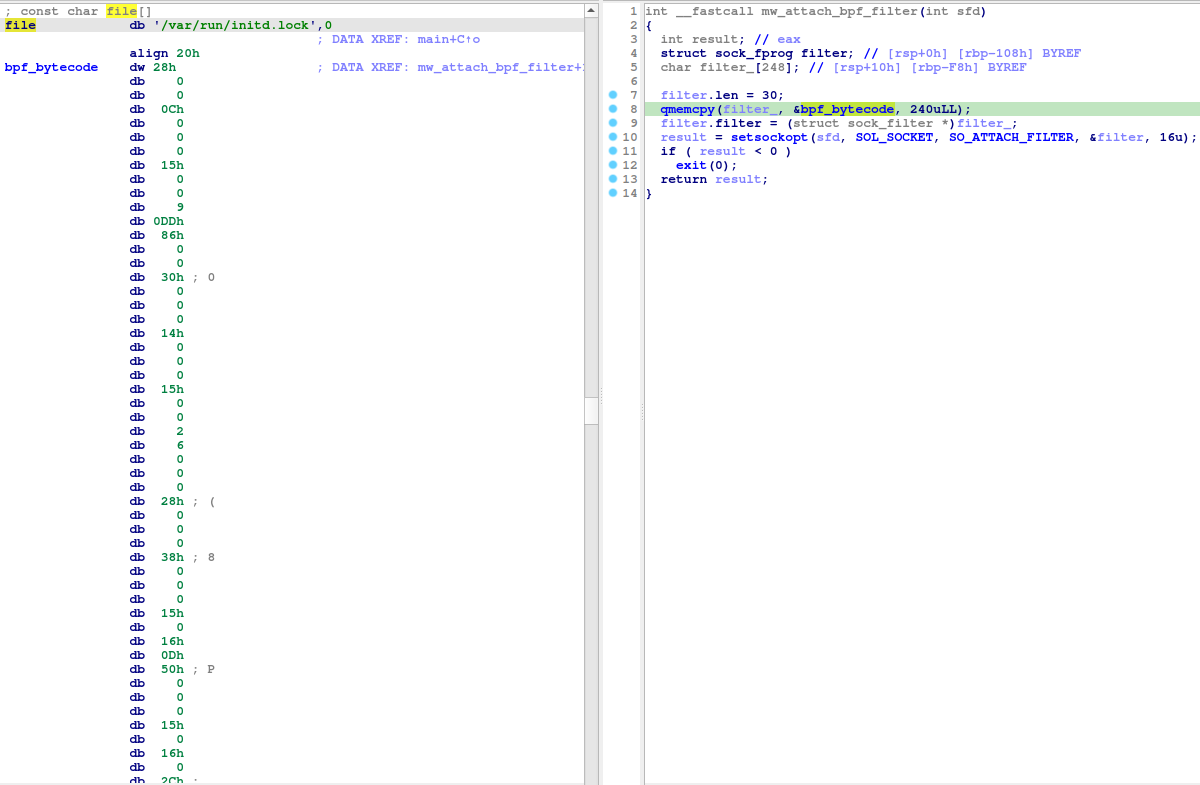
$ xxd -c 8 -g 1 bpf.o
00000000: 28 00 00 00 0c 00 00 00 (.......
00000008: 15 00 00 09 dd 86 00 00 ........
00000010: 30 00 00 00 14 00 00 00 0.......
00000018: 15 00 00 02 06 00 00 00 ........
00000020: 28 00 00 00 38 00 00 00 (...8...
00000028: 15 00 16 0d 50 00 00 00 ....P...
00000030: 15 00 16 00 2c 00 00 00 ....,...
00000038: 15 00 01 00 84 00 00 00 ........
00000040: 15 00 00 14 11 00 00 00 ........
00000048: 28 00 00 00 38 00 00 00 (...8...
00000050: 15 00 11 10 bb 01 00 00 ........
00000058: 15 00 00 11 00 08 00 00 ........
00000060: 30 00 00 00 17 00 00 00 0.......
00000068: 15 00 00 06 06 00 00 00 ........
00000070: 28 00 00 00 14 00 00 00 (.......
00000078: 45 00 0d 00 ff 1f 00 00 E.......
00000080: b1 00 00 00 0e 00 00 00 ........
00000088: 48 00 00 00 10 00 00 00 H.......
00000090: 15 00 09 00 50 00 00 00 ....P...
00000098: 15 00 08 07 bb 01 00 00 ........
000000a0: 15 00 01 00 84 00 00 00 ........
000000a8: 15 00 00 07 11 00 00 00 ........
000000b0: 28 00 00 00 14 00 00 00 (.......
000000b8: 45 00 05 00 ff 1f 00 00 E.......
000000c0: b1 00 00 00 0e 00 00 00 ........
000000c8: 48 00 00 00 10 00 00 00 H.......
000000d0: 15 00 01 00 bb 01 00 00 ........
000000d8: 15 00 00 01 16 00 00 00 ........
000000e0: 06 00 00 00 00 00 04 00 ........
000000e8: 06 00 00 00 00 00 00 00 ........
A BPF instruction is 8 bytes in length. I’ve formatted the above hex dump so that each line represents a cBPF instruction. capstone can be used to disassemble this bytecode.
In [1]: from capstone import *
In [2]: md = Cs(CS_ARCH_BPF, CS_MODE_BPF_CLASSIC)
In [3]: with open("bpf.o", "rb") as ff:
...: data = ff.read()
...: linenum = 0
...: for i in md.disasm(data, 0):
...: print(f"{j}: {i.mnemonic} {i.op_str}")
...: linenum += 1
0: ldh [0xc]
1: jeq 0x86dd, +0x0, +0x9
2: ldb [0x14]
3: jeq 0x6, +0x0, +0x2
4: ldh [0x38]
5: jeq 0x50, +0x16, +0xd
6: jeq 0x2c, +0x16, +0x0
7: jeq 0x84, +0x1, +0x0
8: jeq 0x11, +0x0, +0x14
9: ldh [0x38]
10: jeq 0x1bb, +0x11, +0x10
11: jeq 0x800, +0x0, +0x11
12: ldb [0x17]
13: jeq 0x6, +0x0, +0x6
14: ldh [0x14]
15: jset 0x1fff, +0xd, +0x0
capstone failed to disassemble the 17th instruction. This corresponds to the cBPF bytecode:
b1 00 00 00 0e 00 00 00
Looking at the cBPF bytecode generated by tcpdump earlier (see eBPF vs cBPF section), the above bytecode corresponds to the following instruction. Perhaps, capstone is not yet aware of this bytecode-instruction mapping.
ldxb 4*([14]&0xf)
I removed the above ldxb instruction-specific bytecode from the hex dump, disassembled the remaining bytecode using capstone and then added the ldxb instruction at the appropriate position in the instruction sequence.
0: ldh [0xc]
1: jeq 0x86dd, +0x0, +0x9
2: ldb [0x14]
3: jeq 0x6 , +0x0, +0x2
4: ldh [0x38]
5: jeq 0x50, +0x16, +0xd
6: jeq 0x2c, +0x16, +0x0
7: jeq 0x84, +0x1, +0x0
8: jeq 0x11, +0x0, +0x14
9: ldh [0x38]
10: jeq 0x1bb, +0x11, +0x10
11: jeq 0x800, +0x0, +0x11
12: ldb [0x17]
13: jeq 0x6, +0x0, +0x6
14: ldh [0x14]
15: jset 0x1fff, +0xd, +0x0
16: ldxb 4*([14]&0xf)
17: ldh [x+0x10]
18: jeq 0x50, +0x9, +0x0
19: jeq 0x1bb, +0x8, +0x7
20: jeq 0x84, +0x1, +0x0
21: jeq 0x11, +0x0, +0x7
22: ldh [0x14]
23: jset 0x1fff, +0x5, +0x0
24: ldxb 4*([14]&0xf)
25: ldh [x+0x10]
26: jeq 0x1bb, +0x1, +0x0
27: jeq 0x16, +0x0, +0x1
28: ret 0x40000
29: ret 0x0
Interpreting BPFDoor’s BPF Bytecode
BPFDoor attaches the cBPF program to a AF_PACKET socket. So, packet filtering occurs at layer 2 of the network stack. Let’s look at each instruction line-by-line.
0: ldh [0xc]
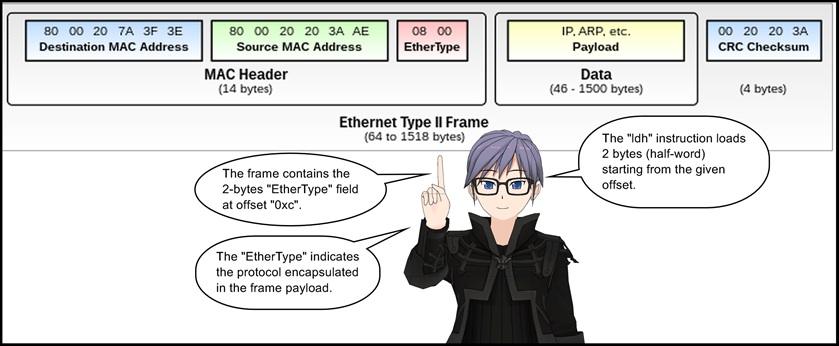
1: jeq 0x86dd, +0x0, +0x9
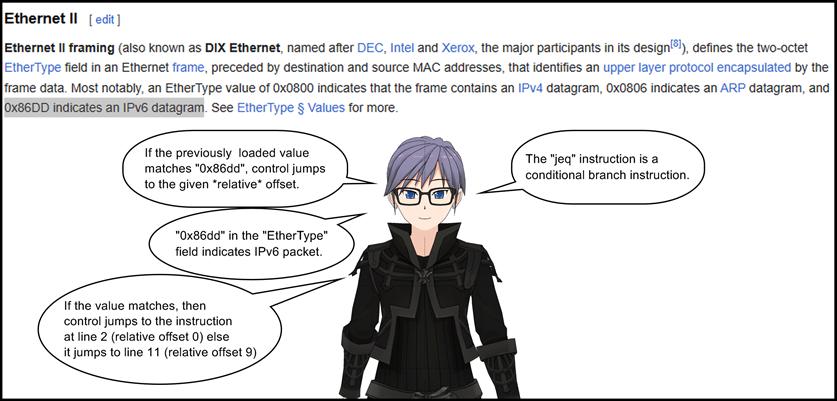
2: ldb [0x14]
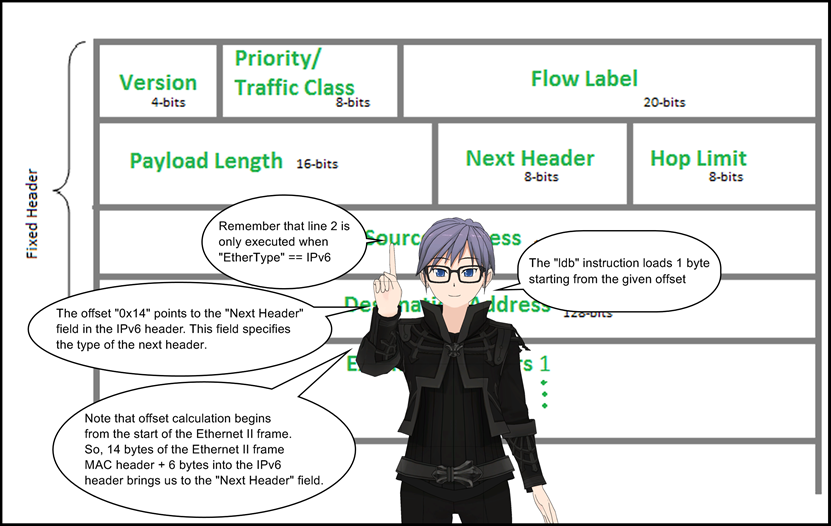
3: jeq 0x6 , +0x0, +0x2
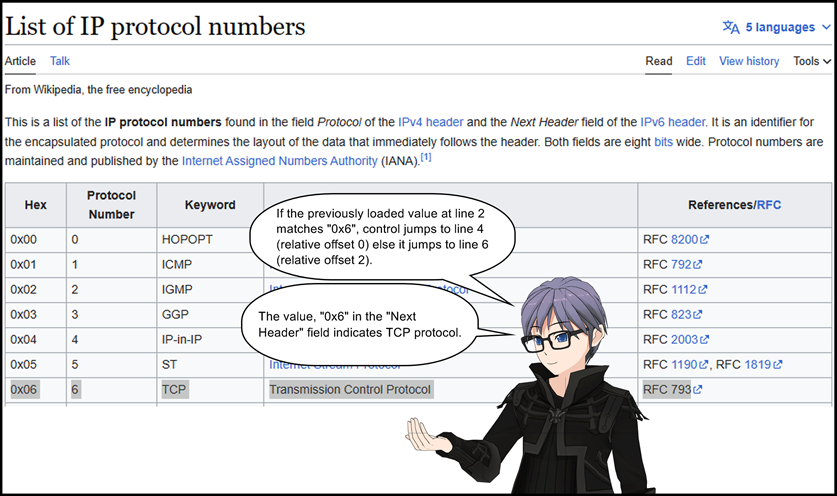
4: ldh [0x38]
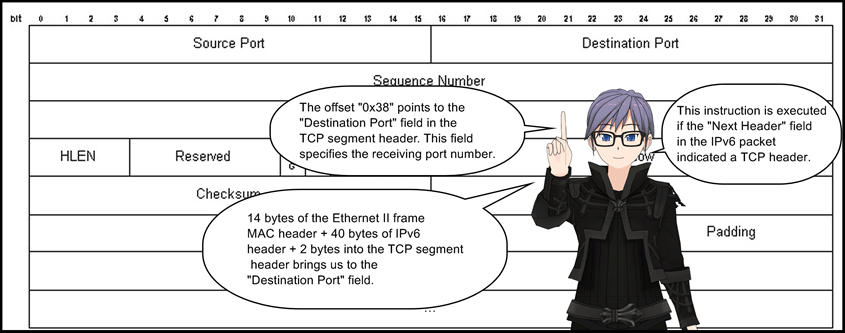
5: jeq 0x50, +0x16, +0xd
If the previously loaded value at line 4 matches 0x50, control jumps to line 28 (relative offset 0x16) else it jumps to line 19 (relative offset 0xd). This instruction checks if the destination port number is 80.
6: jeq 0x2c, +0x16, +0x0
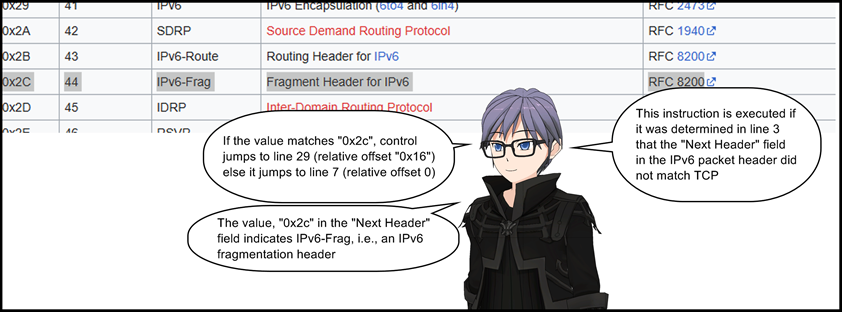
7: jeq 0x84, +0x1, +0x0
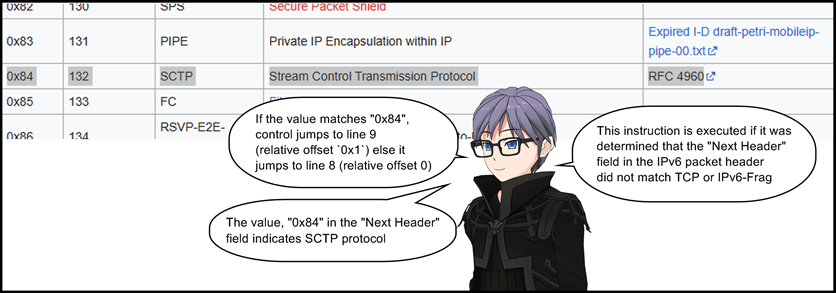
8: jeq 0x11, +0x0, +0x14
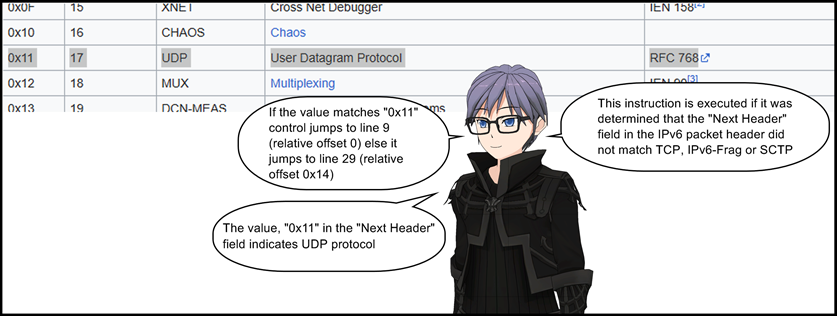
9: ldh [0x38]
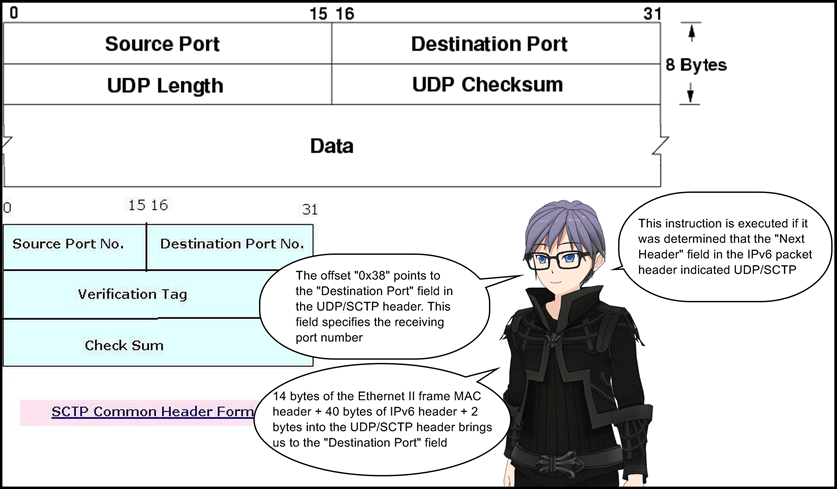
10: jeq 0x1bb, +0x11, +0x10
If the previously loaded value at line 9 matches 0x1bb, control jumps to line 28 (relative offset 0x11) else it jumps to line 27 (relative offset 0x10). This instruction checks if the destination port number is 443
11: jeq 0x800, +0x0, +0x11
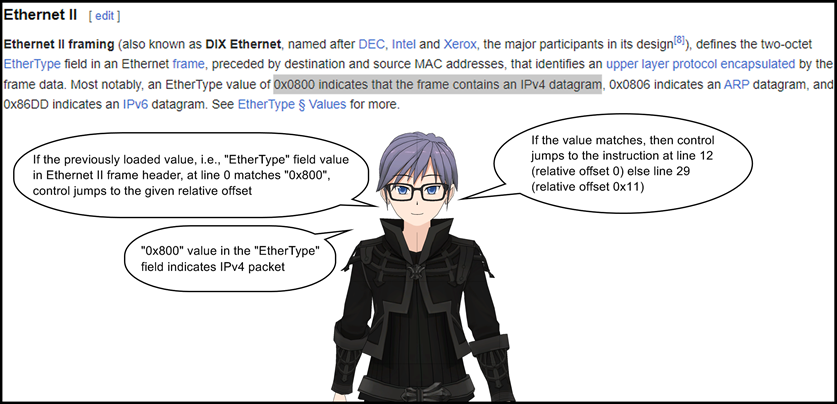
12: ldb [0x17]
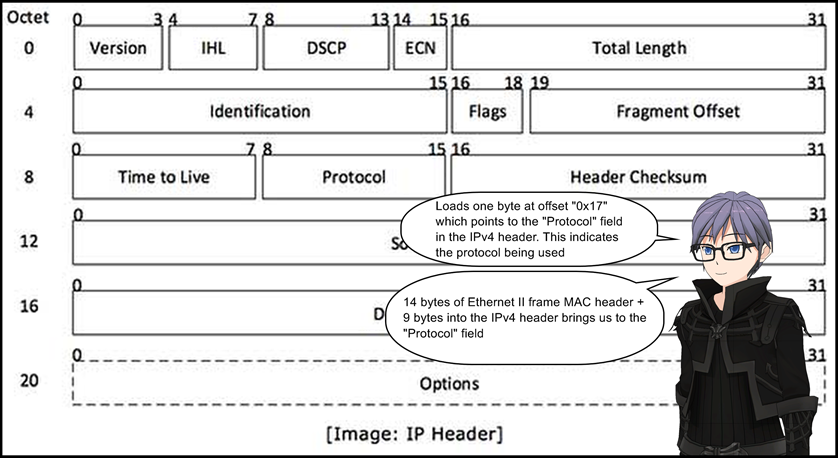
13: jeq 0x6, +0x0, +0x6
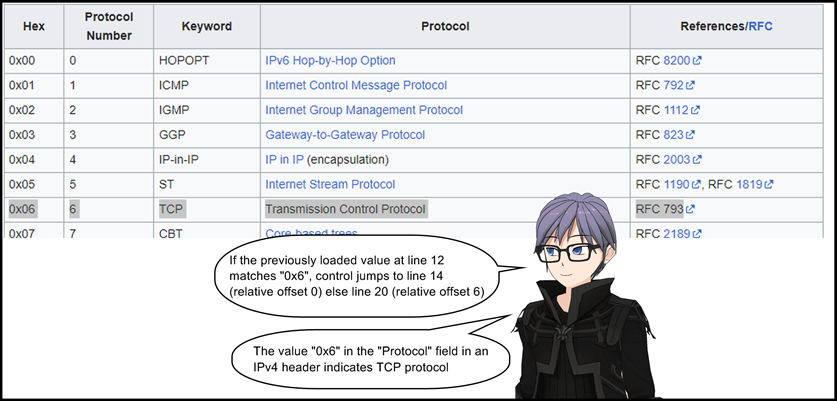
14: ldh [0x14]
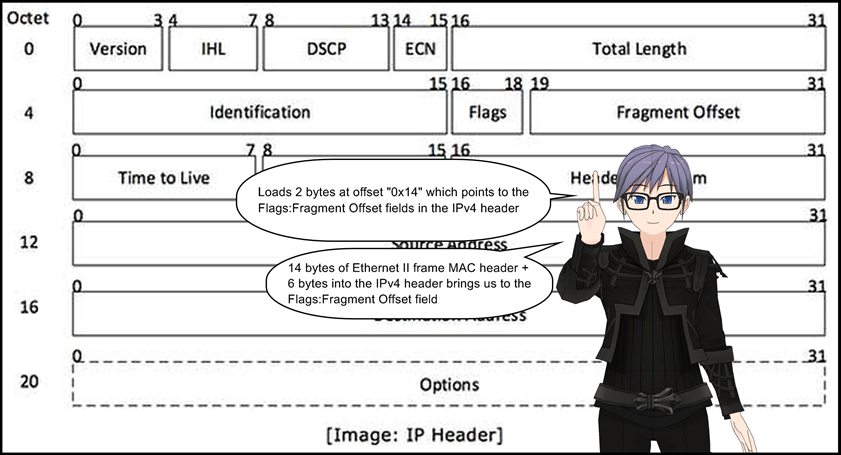
15: jset 0x1fff, +0xd, +0x0
This instruction performs a bitwise AND operation between the previously loaded value at line 14 and 0x1fff. If the result is non-zero, control jumps to line 29 (relative offset 0xd) else line 16 (relative offset 0). This instruction basically looks at the value of the Fragment Offset field. If it is non-zero, control jumps to line 29 else line 16.
16: ldxb 4*([14]&0xf)
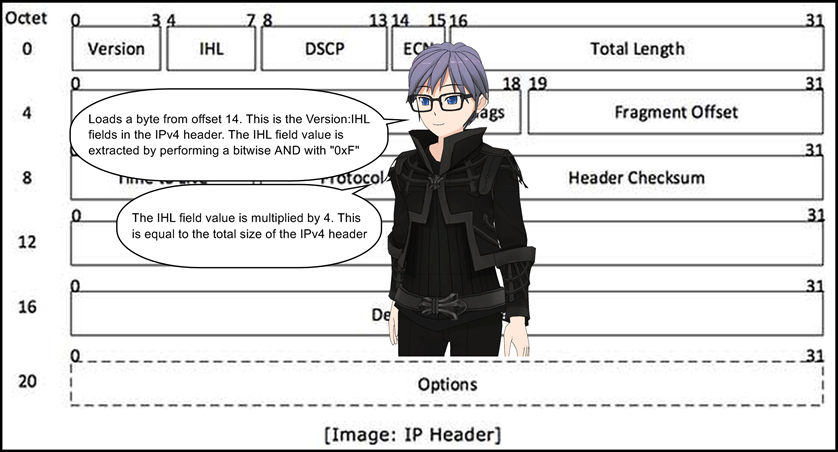
17: ldh [x+0x10]
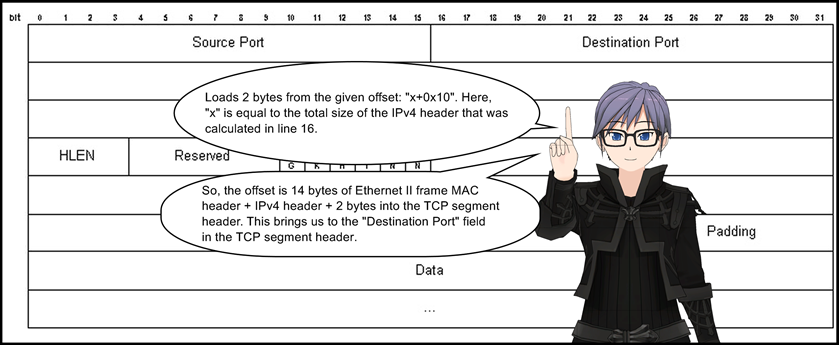
18: jeq 0x50, +0x9, +0x0
If the previously loaded value at line 17 matches 0x50, control jumps to line 28 (relative offset 0x9) else it jumps to line 19 (relative offset 0). This instruction checks if the destination port number is 80.
19: jeq 0x1bb, +0x8, +0x7
If the previously loaded value at line 17 matches 0x1bb, control jumps to line 28 (relative offset 0x8) else it jumps to line 27 (relative offset 0x7). This instruction checks if the destination port number is 443.
20: jeq 0x84, +0x1, +0x0
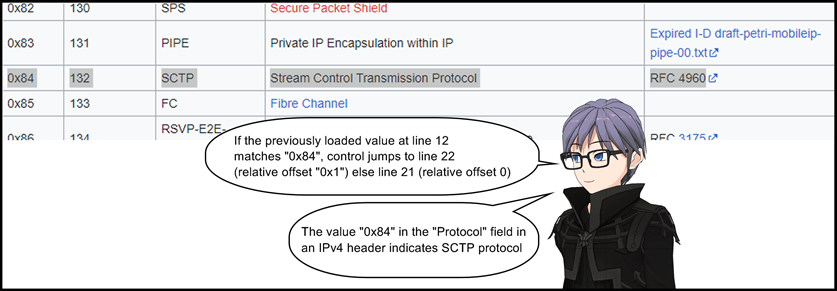
21: jeq 0x11, +0x0, +0x7

22: ldh [0x14]

23: jset 0x1fff, +0x5, +0x0
This instruction performs a bitwise AND operation between the previously loaded value at line 14 and 0x1fff. If the result is non-zero, control jumps to line 29 (relative offset 0x5) else line 24 (relative offset 0). This instruction basically looks at the value of the Fragment Offset field. If it is non-zero, control jumps to line 29 else line 24.
24: ldxb 4*([14]&0xf)

25: ldh [x+0x10]
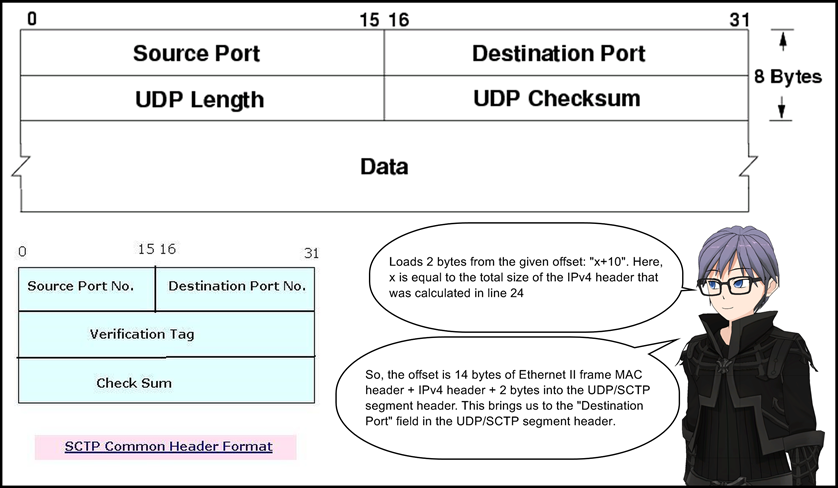
26: jeq 0x1bb, +0x1, +0x0
If the previously loaded value at line 25 matches 0x1bb, control jumps to line 28 (relative offset 0x1) else it jumps to line 27 (relative offset 0). This instruction checks if the destination port number is 443.
27: jeq 0x16, +0x0, +0x1
If the previously loaded value matches 0x16, control jumps to line 28 (relative offset 0) else it jumps to line 29 (relative offset 0x1). This instruction checks if the destination port number is 22.
28: ret 0x40000
A non-zero return indicates a packet match.
29: ret 0x0
A zero return indicates a packet no-match.
Summary
BPFDoor’s cBPF bytecode filters according to the following rules:
- Match only on IPv4 or IPv6 packets.
- Match only on TCP traffic on ports 80, 443 and 22. In case of IPv4, don’t match on fragmented packets. There is no TCP fragmentation over IPv6.
- Match only on UDP/SCTP traffic on ports 443 and 22. In both IPv4 and IPv6 don’t match on fragmented packets.
I think DeepInstinct’s blog about BPFDoor missed to point out that UDP traffic on only ports 443 and 22 are captured and not port 80.
BPFdoor guides the kernel to set up its socket to only read UDP, TCP, and SCTP traffic coming through ports 22 (ssh), 80 (http), and 443 (https).
The flowchart below shows the overall control flow of the BPF program:
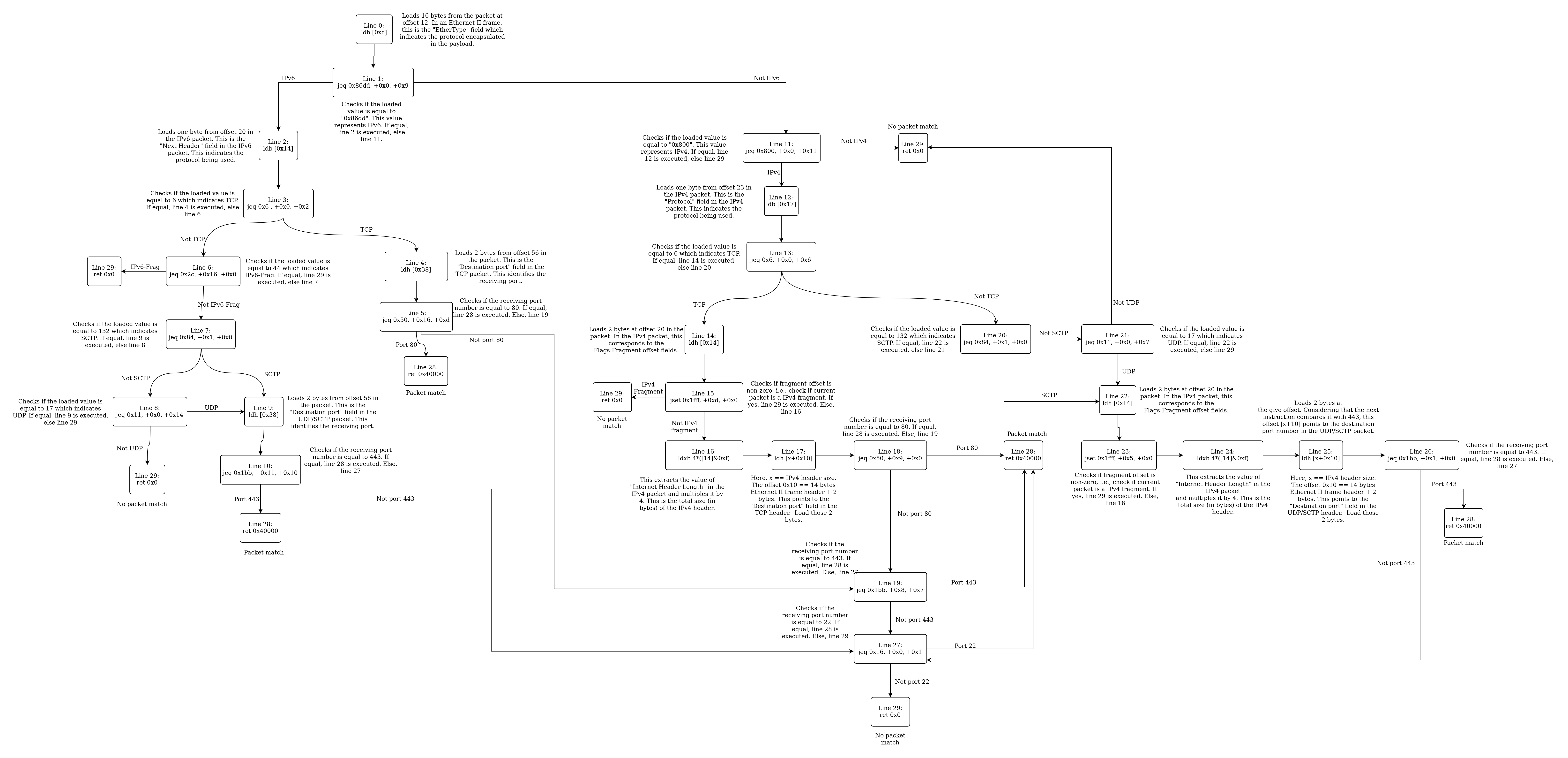
References
- BPFDoor Malware Evolves – Stealthy Sniffing Backdoor Ups Its Game
- Capstone - GitHub
- An intro to using eBPF to filter packets in the Linux kernel
- eBPF - An Overview
- A thorough introduction to eBPF
- What is the difference between BPF and eBPF?
- Linux Socket Filtering aka Berkeley Packet Filter (BPF)
- Ethernet frame
- IPv6 packet
- Transmission Control Protocol
- Internet Protocol version 6 (IPv6) Header
- List of IP protocol numbers
- The Transmission Control Protocol
- UDP header.png
- Stream control transmission protocol (SCTP)
- IPv4 - Packet Structure